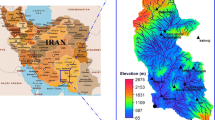Abstract
The uncertainty of modeling input will increase the simulation error, and this situation always happens in a model without user-friendly interface. WinVAST model, developed by the University of Virginia in 2003, treats an entire multi-catchment by a tree-view structure. Its extra computer programs can connect geographic information system (GIS). Model users can prepare all the necessary information in ArcGIS. Extracting information from GIS interface can not only decrease the inconvenience of data input, but also lower the uncertainty due to data preparation. The Daiyuku Creek and Qupoliao Creek in the Fei-tsui reservoir watershed in Northern Taiwan provided the setting for the case study reported herein. The required information, including slope, stream length, subbasin area, soil type and land-use condition, for WinVAST model should be prepared in a Microsoft Access database, which is the project file of WinVAST with extension mdb. In ArcGIS interface, when the soil layer, land-use layer, and Digital Elevation Model (DEM) map are prepared, all the watershed information can be created as well. This study compared the simulation results from automatically generated input and manual input. The results show that the relative simulation error resulting from the rough process of data input can be around 30% in runoff simulation, and even reach 70% in non-point source pollution (NPSP) simulation. It could conclude that GIS technology is significant for predicting watershed responses by WinVAST model, because it can efficiently reduce the uncertainty induced by input errors.
Similar content being viewed by others
References
Bedient, P. B. and Huber, W. C.: 2002, Hydrology and Floodplain Analysis.Prentice-Hall, Inc., Upper Saddle River, N.J., USA.
Chaubey, I., Haan, C. T., Salisbury, J. M. and Grunwald, S.: 1999, ‘Quantifyingmodel output uncertainty due to spatial variability of rainfall’, Journal of the AmericanWater Resources Association 35(5), 1113–1123.
Donigian, A. S. and Huber, W. C.: 1991, Modeling of nonpoint source water qualityin urban and non-urban areas. Environmental Research Laboratory. Office of Research andDevelopment, U.S. EPA, Athens, G.A., USA.
Drechsler, M.: 1998, ‘Sensitivity analysis of complex models’, BiologicalConservation 86, 401–412.
Faures, J. M., Goodrich, D. C., Woolhiser, D. A. and Sorooshian, S.: 1995, ‘Impact of small-scale spatial variability on runoff modeling’, Journal of Hydrology 173, 309–326.
Kaighn, R. J.: 1993, Improvement to Virginia Storm (VAST) Hydrologic WatershedModel including Detention Pond Pollution Routing. Department of Civil Engineering, Universityof Virginia, Charlottesville, V.A., USA.
Klepper, O.: 1997, ‘Multivariate aspects of model uncertainty analysis: tools forsensitivity analysis and calibration’, Ecological Modelling 101, 1–13.
Lung, W. S.: 2001, Water Quality Modeling For Wasteload Allocations andTMDLs. John Wiley and Sons.
McCoy, J. and Johnston, K.: 2001, Using ArcGIS Spatial Analyst. ESRI Press.
O'Neill, R. V. and Gardner, R. H.: 1979, ‘Source of uncertainty in ecologicalmodels. Methodology in systems modeling and simulation’, North Holland, Amsterdam, 447–463.
Tisdale, T. S., Kaighn, R. J. and Yu, S. L.: 1996, The Virginia storm (VAST)model for stormwater management – User's Guide version 6.0. University of Virginia, Charlottesville, V.A., USA.
Vicente, L. L.: 1996, ‘On the effect of uncertainty in spatial distribution ofrainfall on catchment modeling’, Catena 28, 107–119.
Wanielista, M., Kersten, R. and Eaglin, R.: 1997, Hydrology-Water Quantityand Quality Control. John Wiley and Sons, Inc., 91–96.
Yu, S. L., Stanford, R. L. and Zhai, Y. Y.: 2003, Virginia stormwater model forwindows–User's Manual version 1.0.. University of Virginia, Charlottesville, V.A., USA.
Author information
Authors and Affiliations
Corresponding author
Rights and permissions
About this article
Cite this article
Chang, CL., Lo, SL. & Yu, SL. Role of Geographic Information System (GIS) in Watershed Simulation By Winvast Model. Environ Monit Assess 121, 289–301 (2006). https://doi.org/10.1007/s10661-005-9123-3
Received:
Accepted:
Published:
Issue Date:
DOI: https://doi.org/10.1007/s10661-005-9123-3




